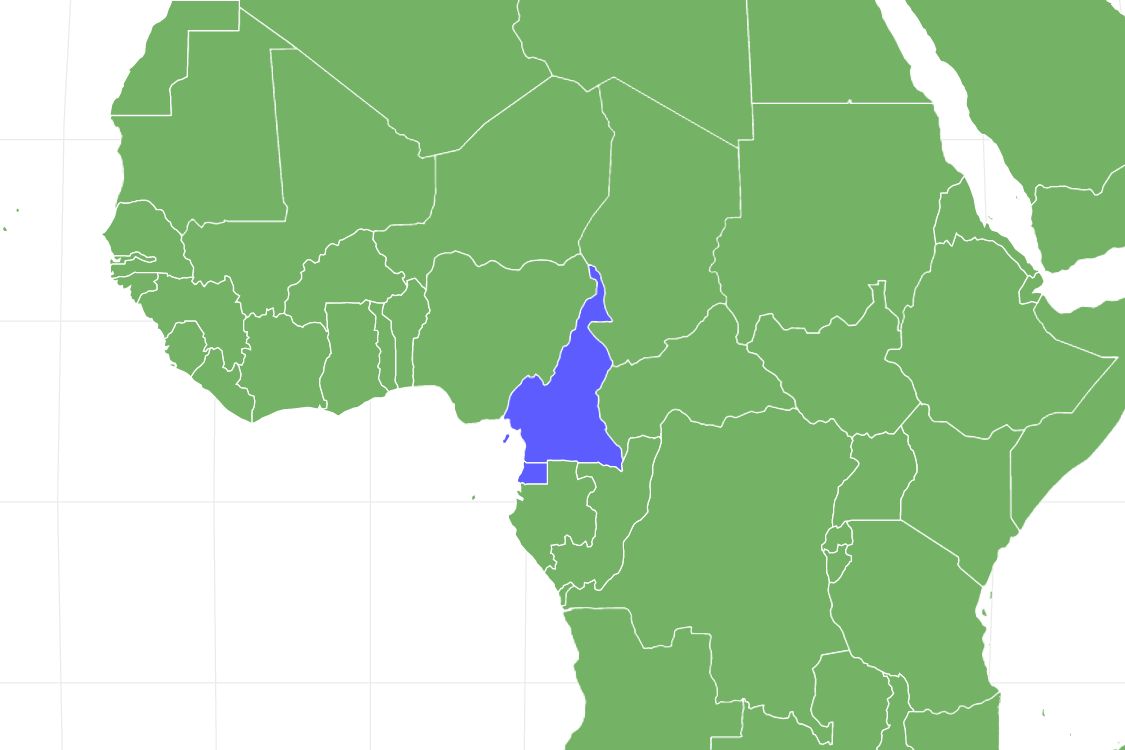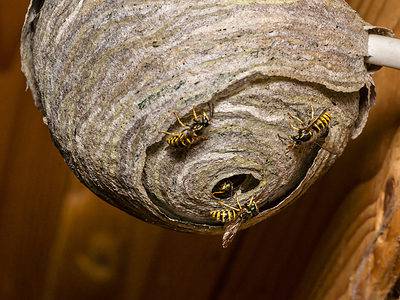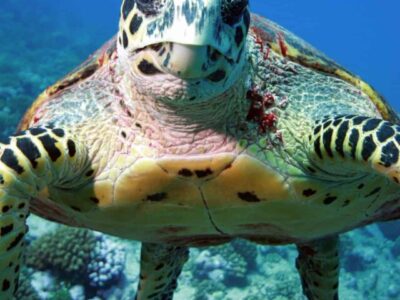Goliath Frog
Conraua goliath
Does not have a vocal sac.
Advertisement
Goliath Frog Scientific Classification
- Kingdom
- Animalia
- Phylum
- Chordata
- Class
- Amphibia
- Order
- Anura
- Family
- Conrauidae
- Genus
- Conraua
- Scientific Name
- Conraua goliath
Read our Complete Guide to Classification of Animals.
Goliath Frog Conservation Status
Goliath Frog Facts
- Main Prey
- insects, fish, crustaceans, mollusks, amphibians
- Name Of Young
- tadpole
- Group Behavior
- Solitary
- Fun Fact
- Does not have a vocal sac.
- Estimated Population Size
- unknown
- Biggest Threat
- hunting
- Most Distinctive Feature
- massive size
- Other Name(s)
- Giant Slippery Frog, Goliath Bullfrog
- Gestation Period
- 85-95 days
- Average Spawn Size
- several hundred-several thousand
- Habitat
- freshwater, tropical, rainforest
- Predators
- humans
- Diet
- Carnivore
- Lifestyle
- Solitary
- Type
- amphibian
- Common Name
- Goliath Frog
- Number Of Species
- 1
- Location
- Africa
View all of the Goliath Frog images!
“The Goliath Frog is the largest frog in the world!”
The Goliath Frog is an endangered species of frog that lives exclusively in Equatorial Guinea and Cameroon in Africa. It can also be referred to as a goliath bullfrog or a giant slippery frog. This amphibian got its name due to its large size. These amazing creatures can grow to be about the size of a pet cat.
5 Incredible Goliath Frog Facts!
- Goliath frogs are endangered.
- Goliath frogs can leap forward ten feet.
- Goliath frogs are nocturnal.
- Goliath frogs move heavy rocks to build nests.
- Female Goliath frogs are smaller than males.
Evolution And History
This frog has a long history, dating back more than 250 million years to the Paleozoic era, and is one of the small numbers of amphibians that are still in existence that lived before dinosaurs roamed the earth. The oldest fossil found of a frog was from the early Triassic era, 251 million to 247 million years ago, although this ancient ancestor, Triadobatrachus may be from even further back than originally thought. Triadobatrachus is the oldest known member of the frog’s lineage.
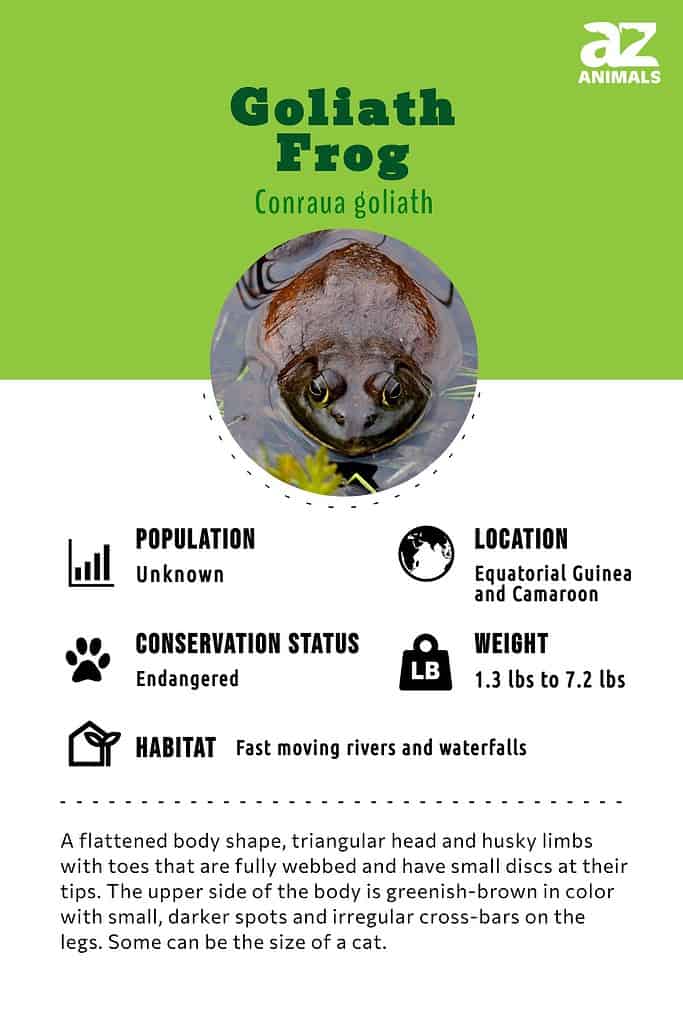
Scientific Name
The common name of this frog is Goliath Frog, with alternate names Giant Slippery Frog and Goliath Bullfrog. The scientific name of the frog is Conraua goliath. It belongs to the phylum Chordata, class Amphibia in the family Conrauidae.
The word conraua is thought to come from a German man named Gustav Conrau, who may have collected the first Conraua robusta, otherwise known as the Cameroon slippery frog. The word goliath is derived from the Latin goliath, from the Hebrew word golyath, meaning “a giant.” Likely, the most well-known use of goliath refers to the Philistine giant David defeated in the old testament of the bible.
Goliath Frog Vs. African Bullfrog
The Goliath frog is sometimes confused with the African bullfrog due to some similarities the two species share. For example, both of these frogs are native to Africa, are carnivorous, and are much larger than many other frog species. There are, however, more than a few distinguishing differences between these two frogs.
First, although the African bullfrog is considered one of the largest frogs, it is significantly smaller than the goliath frog. African bullfrogs typically weigh just over two pounds and measure between four and nine inches in length. Another example of how these species differ is the loud croak an African bullfrog makes. Additionally, African bullfrogs hibernate in the dry season whereas goliath frogs do not.
Appearance
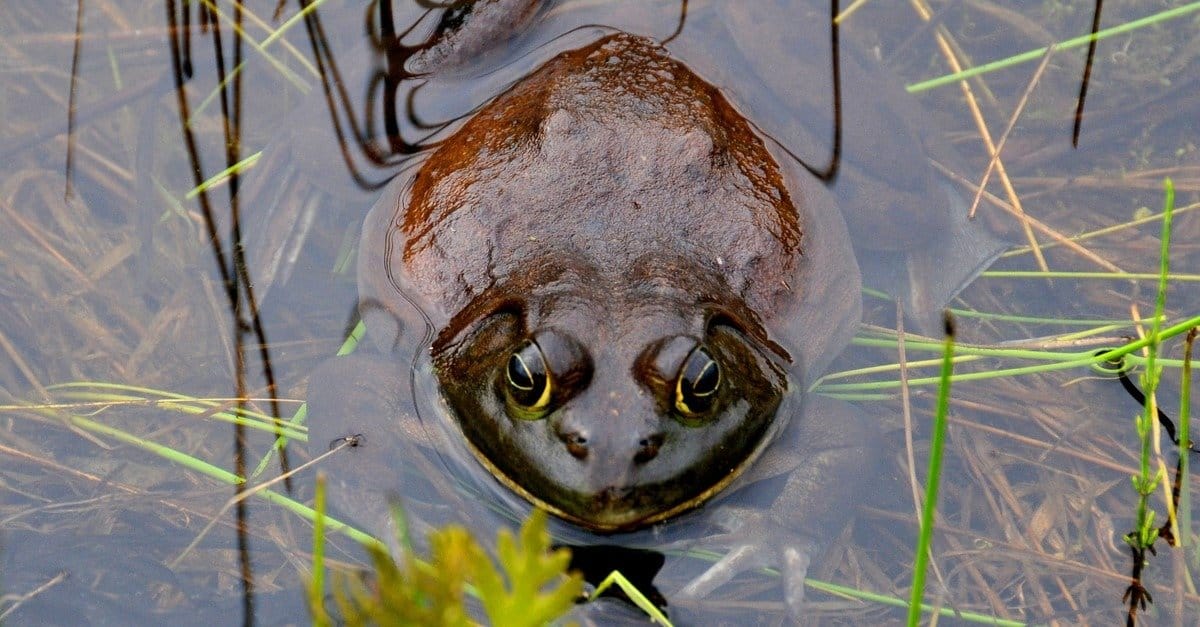
The Goliath frog has coloring that helps to camouflage them with the environment.
©meunierd/Shutterstock.com
These frogs have bumpy skin that contains glands that they use to drink water and obtain oxygen. The upper side of the animal’s body is called the dorsal side, while the bottom side is referred to as the ventral side. The dorsal coloring is usually a brownish-green color with various spots. The ventral coloring can be either yellow-green or yellow-orange. Their coloring helps to camouflage themselves with their environment. As a mature adult, these frogs can reach up to 32 centimeters long, which is six times the height of a golf tee. Their weight can vary between 1.3 lbs (about three times as heavy as a hamster) and 7.2 lbs (about half the weight of a bowling ball).
Types Of
While the goliath frog is its own species, there are six other species related to these frogs that belong to the Conrauidae family. The related species are:
- Allen’s slippery frog (Conraua alleni)
- Conraua beccarii
- Conraua crassipes
- Togo slippery frog (Conraua derooi)
- Cameroon slippery frog (Conraua robusta)
- Atewa Slippery Frog (Conraua sagyimase) – this is a new, critically endangered species from central Ghana.
Behavior
These frogs are solitary animals. These amphibians can swim very fast but will often wait around for prey to catch with their long tongue. They can leap large distances, up to ten feet, despite their tremendous size. They are also quite strong. They are able to move heavy rocks to create nests, sometimes over four pounds. This is likely the reason these creatures evolved to be so big.
Habitat
These frogs are native to Africa. The range of their habitat is limited, existing only in the regions of Cameroon and Equatorial Guinea. Their natural habitats are freshwater and tropical environments, within the rainforest and near rivers. They can also be found in zoos around the world, such as the San Diego Zoo and the San Fransisco Zoo, both located in California.
Diet
Adult frogs are carnivorous. They eat a variety of organisms such as insects, fish, crustaceans, mollusks, amphibians including smaller frogs, and sometimes small mammals. Some of the species these frogs like to snack on include dragonflies, worms, spiders, newts, salamanders, crabs, and small snakes. These are just some examples of their diverse diet. It has even been documented that one of these giants had eaten a bat, therefore these frogs could have additional prey that is not yet known to researchers.
Tadpoles are herbivores and feed on only one plant species called Podostemaceae, which is a type of river weed found in tropical habitats.
Predators And Threats
The only known predator of these frogs is humans. However, potential predators include large lizards such as monitor lizards, crocodiles, and snakes.
Tadpoles may become prey to a few predators including birds, snakes, dragonfly larvae, and hedgehogs.
Humans are the biggest threat to these frogs. Hunting these frogs for their meat and exporting them in large numbers for the pet trade have been the two main contributing factors to the decline of this species for many years. Farming and development are also destroying their natural habitat. As their habitat continues to degenerate, their population declines as well.
Reproduction And Life Cycle
These frogs mate through sexual reproduction and lay eggs, similarly to other frog species. Before mating, male frogs will build a nest for the offspring. Sometimes the male moves large rocks to create the nest. The male frog uses a call that is different than most other frogs. This is because this frog lacks a vocal sac. Instead, a whistling sound is what is produced from his mouth.
Once the couple mates, the male frog goes on his way. The female frog lays several hundred to several thousand eggs. After 85-95 days, the eggs hatch, and tadpoles are released into the water. The mother frog does not take care of her tadpoles the way other animals would care for their young. They are independent and must find their own food. The tadpoles reach maturity around ten to twelve months old.
These frogs usually live around 15 years in the wild. Although there have been goliath frogs that lived to 20 years in captivity, they do not thrive when not in their natural habitat.
Population
Unfortunately, it is unknown exactly how many of these amazing animals exist in the wild today. What is known, however, is that the population has been decreasing steadily and continues to do so. According to IUCN, the International Union for the Conservation of Nature, the status of this frog is endangered and is included in their ”Red List of Threatened Species.”
View all 170 animals that start with GGoliath Frog FAQs (Frequently Asked Questions)
What is a Goliath frog?
A Goliath frog, or Giant slippery bullfrog, is the largest living species of frog.
Where is the Goliath frog from?
The Goliath frog is from Cameroon and Equatorial Guinea, Africa.
Are Goliath Frogs carnivores, herbivores, or omnivores?
Adult Goliath frogs are carnivores, while tadpoles are herbivores.
How much does a Goliath frog weigh?
The weight of a mature goliath frog can vary between 1.3 and 7.2lbs.
Can you own a Goliath frog?
Yes, you can own a Goliath frog as a pet, although it is not recommended because they have specific environmental needs and it can be challenging to provide the right care for these frogs.
How big does the Goliath frog get?
It can grow to over 7lbs and up to 32 cm long.
What does the Goliath frog eat?
The Goliath frog mostly eats insects, fish, crustaceans, mollusks, and amphibians.
How do Goliath frogs protect themselves?
Goliath frogs have colorings that help them blend into their habitat, hidden from predators, and can also swim extremely fast to evade threats.
How long do Goliath frogs live?
Goliath frogs typically live for around 15 years.
How do Goliath Frogs have babies?
Goliath Frogs lay eggs.
Thank you for reading! Have some feedback for us? Contact the AZ Animals editorial team.
Sources
- San Diego Zoo, Available here: https://animals.sandiegozoo.org/animals/goliath-frog
- Animal Diversity Web, Available here: https://animaldiversity.org/accounts/Conraua_goliath/
- New Scientist, Available here: https://www.newscientist.com/article/2213002-worlds-largest-frog-builds-its-own-ponds-using-heavy-rocks/
- Smithsonian Magazine, Available here: https://www.smithsonianmag.com/smart-news/how-did-worlds-largest-frog-get-so-big-possibly-building-its-own-ponds-180972884/
- Amphibiaweb, Available here: https://amphibiaweb.org/species/4691
- Encyclopedia, Available here: https://www.encyclopedia.com/environment/applied-and-social-sciences-magazines/frog-goliath
- The Fact Site, Available here: https://www.thefactsite.com/goliath-frog-facts/
- IUCN Redlist, Available here: https://www.iucnredlist.org/species/5263/96062132#population
- Frog Life, Available here: https://www.froglife.org/info-advice/frequently-asked-questions/spawn-tadpoles-problems/
- Wild Life Learning Center, Available here: https://wildlifelearningcenter.org/animals/arthropods/african-bullfrog/
- Oregon Zoo, Available here: https://www.oregonzoo.org/discover/animals/african-bullfrog-0

